 In October 2011, heavy rainfall poured down the sides of El Salvador’s San Vicente Volcano, nearly four feet of water in 12 days. Coffee plantation employees, working high up on the volcano’s slope began noticing surface cracks forming on steep slopes and in coffee plantations. Cracks herald landslides—places where the wet, heavy upper layers, saturated with water, slide over the less-permeable rocky layers underneath. The workers radioed downslope, keeping close tabs on the rainfall gauge network.
In October 2011, heavy rainfall poured down the sides of El Salvador’s San Vicente Volcano, nearly four feet of water in 12 days. Coffee plantation employees, working high up on the volcano’s slope began noticing surface cracks forming on steep slopes and in coffee plantations. Cracks herald landslides—places where the wet, heavy upper layers, saturated with water, slide over the less-permeable rocky layers underneath. The workers radioed downslope, keeping close tabs on the rainfall gauge network.
Read More
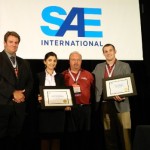 Troy Bouman reaches over, presses play, and the loudspeaker sitting on the desk starts playing the university fight song. But this is no ordinary loudspeaker. This is a carbon nanotube transducer—and it makes sound with heat.
Troy Bouman reaches over, presses play, and the loudspeaker sitting on the desk starts playing the university fight song. But this is no ordinary loudspeaker. This is a carbon nanotube transducer—and it makes sound with heat.
Read More
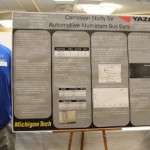 Federal regulations are challenging automakers to wring as many miles as possible from every drop of fuel, and one of the easiest ways to do that is to make lighter vehicles. Last year, one of the world’s leading auto industry suppliers enlisted a Senior Design team at Michigan Technological University to help it do just that.
Federal regulations are challenging automakers to wring as many miles as possible from every drop of fuel, and one of the easiest ways to do that is to make lighter vehicles. Last year, one of the world’s leading auto industry suppliers enlisted a Senior Design team at Michigan Technological University to help it do just that.
Read More
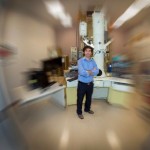 A single drop of blood is teeming with microorganisms—imagine if we could see them, and even nanometer-sized viruses, with the naked eye. That’s a real possibility with what scientists call a “perfect lens.” The lens hasn’t been created yet, but it is a theoretical perfected optical lens made out of metamaterials, which are engineered to change the way the materials interact with light.
A single drop of blood is teeming with microorganisms—imagine if we could see them, and even nanometer-sized viruses, with the naked eye. That’s a real possibility with what scientists call a “perfect lens.” The lens hasn’t been created yet, but it is a theoretical perfected optical lens made out of metamaterials, which are engineered to change the way the materials interact with light.
Read More
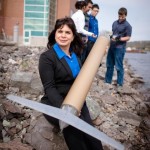 Only 36 faculty across the US were invited to join the Young Investigator Program (YIP) from the Office of Naval Research this year; additionally, only a small percent of faculty receive the CAREER Award from the National Science Foundation (NSF). Nina Mahmoudian, an assistant professor of mechanical engineering-engineering mechanics at Michigan Technological University, is one of a select few to receive both in the same year.
Only 36 faculty across the US were invited to join the Young Investigator Program (YIP) from the Office of Naval Research this year; additionally, only a small percent of faculty receive the CAREER Award from the National Science Foundation (NSF). Nina Mahmoudian, an assistant professor of mechanical engineering-engineering mechanics at Michigan Technological University, is one of a select few to receive both in the same year.
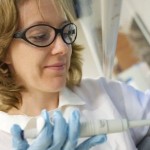 Adrienne Minerick has been named the first associate dean for research and innovation in Michigan Tech’s College of Engineering. Dean of the College of Engineering Wayne Pennington said Minerick will coordinate faculty and staff engagement with each other and with agencies that fund research projects, ranging from single-investigator one-year projects to complex multi-disciplinary projects involving several institutions and spanning years.
Adrienne Minerick has been named the first associate dean for research and innovation in Michigan Tech’s College of Engineering. Dean of the College of Engineering Wayne Pennington said Minerick will coordinate faculty and staff engagement with each other and with agencies that fund research projects, ranging from single-investigator one-year projects to complex multi-disciplinary projects involving several institutions and spanning years.
Read more
 Old rocks hold on to their secrets. Now, a geophysicist at Michigan Technological University has unlocked clues trapped in the magnetic signatures of mineral grains in those rocks. These clues will help clear up the murky history of the Earth’s early core.
Old rocks hold on to their secrets. Now, a geophysicist at Michigan Technological University has unlocked clues trapped in the magnetic signatures of mineral grains in those rocks. These clues will help clear up the murky history of the Earth’s early core.
Read More
 Most people see defects as flaws. A few Michigan Technological University researchers, however, see them as opportunities. Twin boundaries — which are small, symmetrical defects in materials — may present an opportunity to improve lithium-ion batteries. The twin boundary defects act as energy highways and could help get better performance out of the batteries. This finding, published in Nano Letters earlier this year, turns a previously held notion of material defects on its head. Reza Shahbazian–Yassar helped lead the study and holds a joint appointment at Michigan Tech as the Richard & Elizabeth Henes associate professor in nanotechnology and an adjunct associate professor in materials science and engineering. Anmin Nie, a senior postdoctoral researcher in his group, conducted the study.
Most people see defects as flaws. A few Michigan Technological University researchers, however, see them as opportunities. Twin boundaries — which are small, symmetrical defects in materials — may present an opportunity to improve lithium-ion batteries. The twin boundary defects act as energy highways and could help get better performance out of the batteries. This finding, published in Nano Letters earlier this year, turns a previously held notion of material defects on its head. Reza Shahbazian–Yassar helped lead the study and holds a joint appointment at Michigan Tech as the Richard & Elizabeth Henes associate professor in nanotechnology and an adjunct associate professor in materials science and engineering. Anmin Nie, a senior postdoctoral researcher in his group, conducted the study.
Read More
 Drought in the southwest has left only a trickle running through irrigation ditches on farms outside El Paso, Texas. The Rio Grande — called Rio Bravo in Mexico — is what supplies that trickle, struggling to meet water demands in three US states and five in Mexico.
Drought in the southwest has left only a trickle running through irrigation ditches on farms outside El Paso, Texas. The Rio Grande — called Rio Bravo in Mexico — is what supplies that trickle, struggling to meet water demands in three US states and five in Mexico.
As drought continues, and demand grows, researchers like Alex Mayer from Michigan Technological University are looking to new models to improve the region’s drought resiliency. Mayer, a professor of environmental engineering at Michigan Tech, is part of a unique team looking at water resources along a section of the Rio Grande. The National Institute of Food and Agriculture, part of the US Department of Agriculture, has awarded the project a $4.9 million grant to study water shortage and climate change for the next five years in the region.
 Wind turbines appear simple, but it’s the complex engineering behind the technology that makes harnessing the wind seem like a breeze. Bridging the gap between mechanical details and large-scale infrastructure needs of wind turbine technology is also no easy feat.
Wind turbines appear simple, but it’s the complex engineering behind the technology that makes harnessing the wind seem like a breeze. Bridging the gap between mechanical details and large-scale infrastructure needs of wind turbine technology is also no easy feat.
But that’s the research focus of Antonio Velazquez, who earned his PhD from Michigan Technological University last fall, and Assistant Professor Andrew Swartz, Velazquez’s advisor in civil and environmental engineering. Their forward-thinking research on better monitoring systems for wind turbines earned the duo this year’s Bhakta Rath Research Award.
Read More about this